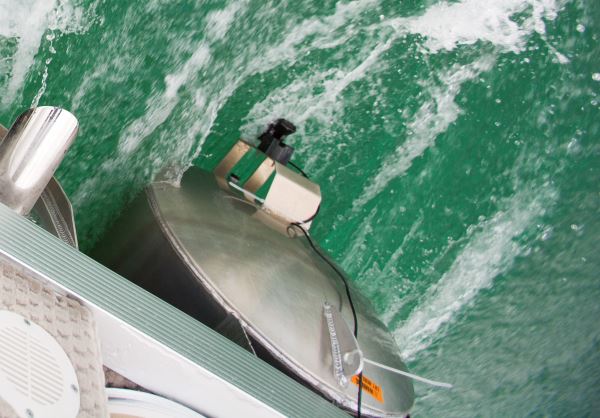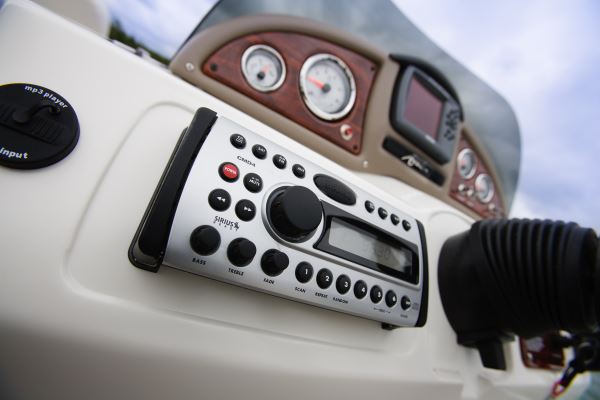.JPG_600.jpg)
Many newer and higher-end pontoons come with digital information centers, whether part of the upgraded package or part of the engine package. For those with entry-level models or older boats, it’s great to upgrade with the latest fishfinder, GPS, marine stereo or electronic gadget with all the bells and whistles. Often many features go unused, and buying the best and latest/greatest may mean overspending for features you don’t need or won’t use. For example, many boaters and fishermen I’ve spoken with are not aware that a simple GPS speedometer can be purchased separately; you don’t need a $1000 fishfinder unit to get a speed reading and map for your boat. Even cheap $100 GPS units have a speedometer with “highest speed” recall capability; in fact, chances are you have a Garmin or other brand GPS in your tow vehicle that will work just fine in your boat as a speedometer. And if you don’t care much about finding fish but want to chart a trip across the lake and back, a handheld GPS will do the job handily.
 For those who need to do more than follow a map or see how fast they are, today’s fishfinders are light years ahead in technology over those offered just a few years ago. Given their capabilities, accuracy and resolution, it’s even more important to mount them properly, locate and mount their transducers correctly, and maintain them with care.
For those who need to do more than follow a map or see how fast they are, today’s fishfinders are light years ahead in technology over those offered just a few years ago. Given their capabilities, accuracy and resolution, it’s even more important to mount them properly, locate and mount their transducers correctly, and maintain them with care.
Signal Strength
To obtain accurate and consistent speed readings, the GPS signal receiver puck must be mounted properly; the best location is on the deck where it can receive a clear satellite signal. The hold drilled for the coaxial cable must allow for easy pass-through when rigging; I’ve seen more than a few damaged by pulling the cable through the deck. The connections at the dash must be clean and tight.
Special precautions must be taken when choosing a location and mounting the transducer puck for the fishfinder. Most pontoons will need a transom-mounted transducer; they are easy to install and provide a good consistent reading. Mounting may require some experimentation to get the most consistent readings. Placement should be in clean water; anything in front of the transducer may interrupt its ability to obtain a good reading from the water.
.JPG_600.jpg) Since it’s exposed when mounted to the back of a pontoon, care must be taken not to damage the transducer; it’s easier than you might think to damage it by running over debris in the water, or even backing it into something when the boat is on the trailer.
Since it’s exposed when mounted to the back of a pontoon, care must be taken not to damage the transducer; it’s easier than you might think to damage it by running over debris in the water, or even backing it into something when the boat is on the trailer.
Fiberglass deck boats can benefit from thru-hull mounting. When mounted through the hull, transducer performance—when installed properly—is as good or better than transom mount, and without the wire and puck exposed to potential damage.
A clear signal path to the lake bottom is necessary for accurate and consistent performance. Most popular hulls use some type of core material (balsa wood, closed-cell foam, etc.) to stiffen the hull and provide strength and flexibility. Transducer pucks can’t read the bottom through core material. The solution is to (carefully!) remove the core material to fit the puck, then epoxy the puck in place—weighting it down as it cures so no air pockets can form. Sealing the unit with more epoxy will ensure its performance for many years, and keep your hull core from allowing in water and eventual rot.
 Wiring And Sealing
Wiring And Sealing
It’s important that the power and ground to the unit are properly routed and connected. The power connection should be fused to provide protection to the unit. As the wires pass through the deck, they should be covered by a stainless clam shell or similar suitable wire cover, filled neatly with silicone sealer to keep water out. The wire run from unit to dash underneath should have at least an inch or two of extra length and “play” to accommodate the fishfinder’s swivel and tilt range. If possible, mount your marine stereo head unit and amps below decks or behind a protective cover that keeps them out of direct weather exposure.
Lastly—if you can’t mount it in a protected place, then protect that expensive head unit with a cover, especially if you don’t remove it when the boat is not in use. Covers are typically available from the manufacturer, or one can be fabricated locally that provides better fit and protection.

